
A recent conversation on the MACC forum was the inspiration for this look at the various special bicycles that were made for cyclemotors in the UK.
The most popular of all the special cyclemotor cycles, the BSA was primarily intended for use with the BSA Winged Wheel engine. It was sold as a complete machine with a Winged Wheel already fitted but could also be bought without a rear wheel as the brochure said "for use with Motorised Wheels of all types", which would have meant a Cyclemaster. A third version was sold as a frame and forks but with no wheels or brakes. This version could be built up to take any cyclemotor. This third version was considerably cheaper because, unlike the other two, it was not subject to Purchase Tax.
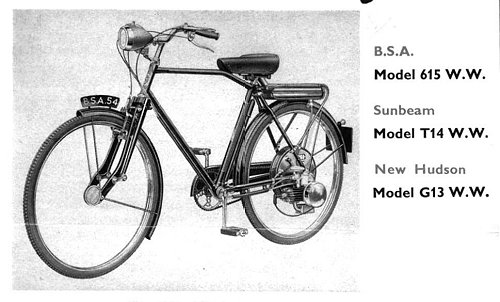
Unlike other cyclemotor frames, the BSA had a Webb spring fork. A cable-operated stirrup brake was the standard fitting, but a calliper or a drum brake were available as options. The three versions were available as gents' or ladies' frames, making six models altogether.
In addition, all six models were also produced with New Hudson or Sunbeam badges.
Having said in the opening paragraph that this article would be about cyclemotor bicycles in the UK, what's this Italian bike doing here? Well firstly, it serves to show how much better these things were done on the Continent, and secondly, it almost made it into the UK.
The British-made cyclemotor frames were little more than normal pedal cycles. Far from being "specially made" any manufacturer that made cycles for the Post Office already had all the jigs and tooling needed to make a cyclemotor frame - even down to the dropped top tube on the gents' models.
On the other hand, the Casalini David was a proper, purpose-built frame with a girder fork and a petrol tank built into the frame. On mainland Europe, frames like these would not be retailed. They'd be supplied to smaller makers who'd build them up complete with an engine and sold to the public as a finished motorised bicycle. We did things differently in the UK, buying cycles and engines separately and then fitting the two together. The main reason for this difference was the peculiar Purchase Tax situation in the UK, which made buying a finished bike more expensive.
So, what's the connection between the Casalini David and the UK? A Casalini David appeared at the 1955 Earls Court Show ... on the Power Pak stand. Power Pak was showing the prototype of its new Mo-Ped. This was a complete, roller drive moped built around the Casalini David frame and forks. The Mo-Ped never went into production.
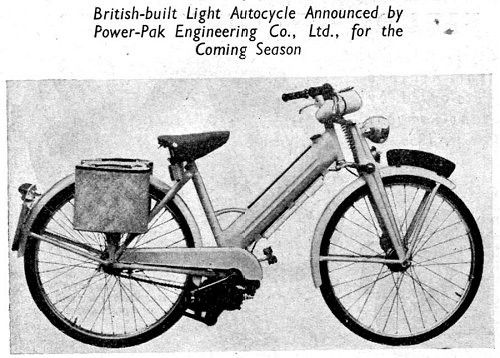
See Three Spires.
The only examples of Dunelt cyclemotor frames we've found are in New Zealand and are fitted with Sanki Sunlight cyclemotors. The Dunelt has an indentation to clear a chain drive (not needed for the Sanki engine) and the pump clips on the right of the down tube to keep the pump clear of an engine in the frame triangle (also not needed for the Sanki engine). These features correspond with the frame used for the Phillips Motorised Bicycle. It looks as if surplus Phillips P36X frames were rebranded as Dunelt Specials and exported to New Zealand. The Dunelt has same the Webb fork used for BSA Winged Wheels rather than the braced rigid fork or the telescopic fork of the Phillips version.
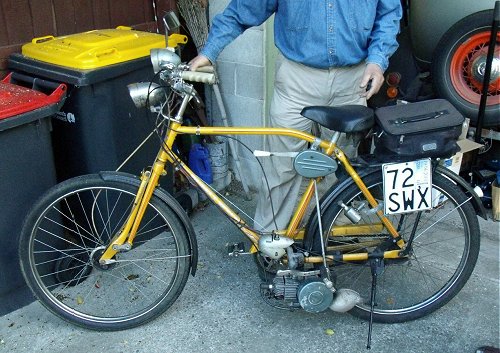
Elswick listed ten motor attachment cycles on its price list. These were Models E1, E2, E3, E4 & E5 with gent's frame and E1L to E5L with lady's frames. However, the catalogue only gives the specifications for the E2, E2L, E5 and E5L versions.
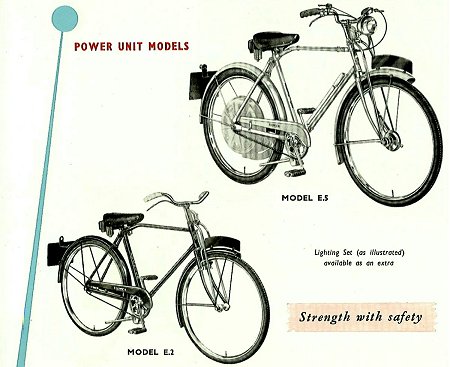
E5 and E5L were supplied without a rear wheel and rear brake, so were intended for use with a Cyclemaster or BSA Winged Wheel. The front fork was fitted with chromium-plated bracing bars and the seat tube was 2 inches shorter than on a normal bicycle - necessitating a dropped top tube on the gent's model. The catalogue shows the front wheel fitted with a drum brake. From the price list, we can deduce that the E4 and E4L models were also supplied without a rear wheel. These were £1 cheaper than the E5 and E5L so probably had a rim brake instead of a drum.
The E2 has two wheels and is described as "suitable for use with any type of modern auxiliary Motor Attachment". The frame and forks are the same design as the E5 and the E2 depicted has a roller-lever stirrup front brake and a coaster brake at the back. With E1 being cheaper than the E2, but E3 more expensive - perhaps the E1 had a stirrup brake at the back and the E3 had a drum at the front? One unusual feature of the E1 to E3 models was that they had 26×1 3/8 rims. The E4 and E5 had a 1¾ section tyre, like most other makes. All had number plates and licence holders and were available in Black or Dove Grey.
The ten Elswick models could also be had under the Hopper marque (models H1 to H5L). Additionally, both Elswicks and Hoppers could be supplied with a Webb spring fork instead of the braced fork - so that makes a total of 40 different Elswick-Hopper models!
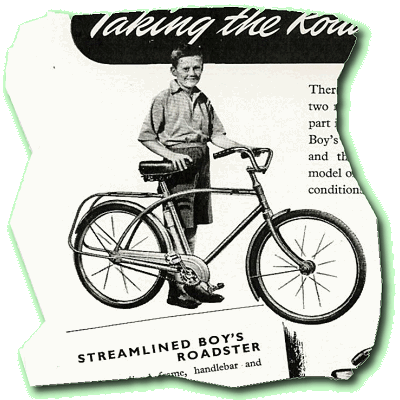
Mercury Industries made pedal cycle mainly for export and, as these were mostly of the heavy duty 'Colonial' style, were ideal for cyclemotors. Mercury struck a deal with Cyclemaster so the Mercury models became the 'official' recommended models for Cyclemaster wheels. To begin with, there were two models: MCMO with an open, lady's frame and MCMD with a diamond, man's frame. They were conventional, roadster type cycles but were built wide enough to take oversize 2-inch section tyres. The finish was 'Polychromatic' grey to match the Cyclemaster.
Back in 1949, and with an eye on the American market, Mercury produced its Streamlined Boy's Roadster cycle. The top tube of this bicycle curved down towards the seat tube and became two curved tubes continuing down to the rear wheel spindle and forming the seat stays of the frame. In 1953, Mercury adapted this design to an adult-sized frame. With an extra strong rack carrying a seat pad and two footresrs, this became Mercury's Cyclemaster Pillion model.
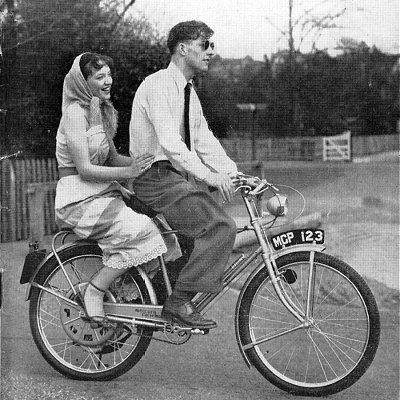
Launched at the same time as the Pillion, Cyclemaster added the Roundsman to its range. This was a low-gravity carrier cycle. Unlike a normal trade bike, it was finished in Polychromatic grey and equipped with a chain guard. It is assumed that this was also made by Mercury but that's not definitely stated in any of Cyclemaster's publicity material.
The New Hudson motor attachment cycles were 'badge-engineered' BSA machines - see part 1.
While Mercury is usually considered to be the 'official' frame for the Cyclemaster, Norman also produced an officially sanctioned Cyclemaster bicycle. The Norman 'took over' from the Mercury in 1954 and this is, no doubt, linked to Norman producing the frames for the Cyclemate.
There were two models: the man's C/MA and the woman's D/MA. In standard form, the cycle was equipped with two 26×1½ wheels but could be supplied without a rear wheel at a saving of £2 10s 6d on the normal price of £16 2s 0d. Rather than list lots of different models, Norman offered different options on their two models. So, 1¾-inch section wheels and tyres could be fitted for an extra 6s 6d. A rack, pillion seat and footrests cost another £2 8s 7d. The Norman man's model, like other makes, has a dropped top tube to allow a lowered saddle height. The standard finish was "Special Mid-Green Polychromatic", like the Cyclemate, but the cycle was available in black as an option.
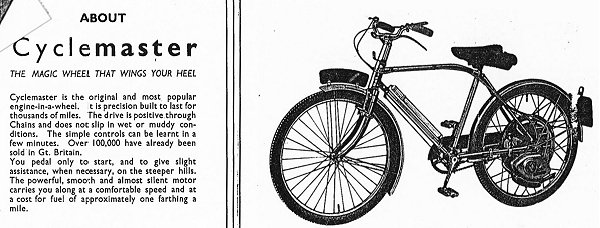
There were four models of Phillips bicycle for cyclemotor units. The P35 had roller-lever stirrup brakes and the P36 had drum brakes, which could be cable or rod operated. P35L and P36L were the women's versions. The man's version had the usual dropped top tube. All models could be supplied without a rear wheel. The Phillips bicycle had bracing bars; a bracket clamped under the steering lock nut supported the upper end of these bars while the lower ends were held by the front wheel nuts. Catalogue illustrations show a forward-facing front number plate fitted across these bars but surviving examples of the Phillips have the more usual fore-and-aft plate on the front mudguard. Phillips bicycles for the Cyclemaster also had a special offset rear rack. This was offset to the left so that the stay on that side would be clear of the Cyclemaster's fuel tank. This 'special' rack was actually a re-working of the rack Phillips made for military bicycles. The military rack was offset to the right so a rifle could be slung along the left side of the bicycle.
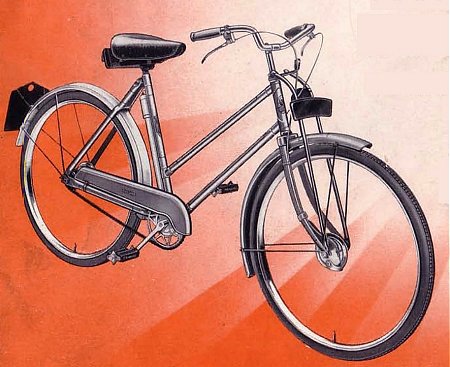
Versions of the Phillips were also sold as complete motorised machines: Phillips's own P36X Motorised Bicycle and Vincent’s Power Cycle.
Raleigh would have nothing to do with cyclemotors and made it clear that the normal lifetime guarantee on a Raleigh cycle would be invalidated by fitting a cyclemotor. This aversion to motors continued until the acquisition of BSA's cycle division in 1957, and work started on producing the first Raleigh Moped.
Sun produced a cyclemotor frame that was specifically intended for the Vincent Firefly. Unlike most other manufacturers' designs, the Sun Motorette used a mixte design of frame with a lowered top tube that divided into stays and continued straight to the rear dropouts. Equipped with a front drum brake, rear coaster brake, rack, number plate, lighting and electric horn, the cycle retailed at £18 17s 6d.
There were four variants of the Sunbeam cyclemotor bicycle: T14 and LT14 were respectively the gents' and ladies' versions. They were also available at the T14WW and LT14WW with a Winged Wheel unit already installed. Apart from the badges and transfers, they were identical to the corresponding BSA models and were sold at identical prices.
Did Three Spires make a cyclemotor bicycle? We've never seen one, but it is possible. Three Spires was the marque used by the Coventry Bicycle Company. Together with Triumph, they formed the Associated Cycle Manufacturers of Coventry. Triumph and Three Spires produced separate ranges of cycles pre-war but, after World War 2 the two makes were merged. The Triumph name was used for the home market while the Three Spires name was applied to exported machines. As Triumph produced a cycle for cyclemotors, it is possible that it could have been exported as a Three Spires.
Combining its own name with that of the most popular of the cyclemotor units, Triumph called its cyclemotor bicycle the Trimaster.
The Trimaster closely followed the pattern of most of the other cyclemotor bicycles with a strengthened frame and a dropped top tube on the man's version. The seat stays were bolted in, roadster-style. The handlebars were equipped with a single roller lever for the front brake, relying on the Cyclemaster's built-in coaster hub for rear wheel braking. Front forks were rigid with no bracing bars.
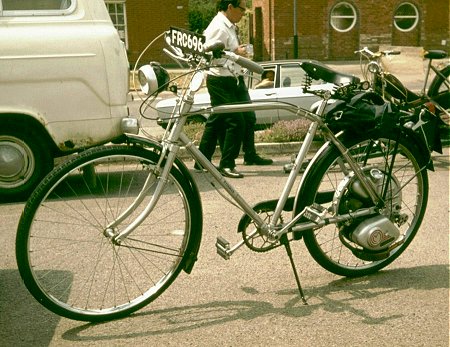
First published in four parts in The MAC between March 2012 and December 2012